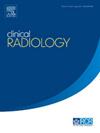使用患者报告的病史问卷来帮助肺癌诊断途径的决策:初级保健胸部x线转诊的单中心观察研究
IF 1.9
3区 医学
Q2 RADIOLOGY, NUCLEAR MEDICINE & MEDICAL IMAGING
引用次数: 0
摘要
目的确定患者报告病史问卷的效用和有效性,以确定指示肺癌的危险信号症状的存在。材料和方法该研究地点于2019年引入了一份纸质筛查问卷,以确定患者报告的危险信号症状的存在。这项为期四周(2020年2月)的回顾性单中心观察性研究确定了症状的患病率,比较了转诊者报告的与患者报告的临床病史,探讨了与胸部x线检查(CXR)结果的关系,并确定了在接下来的两年内被诊断为肺癌的患者。对CXR记者进行了平行横断面调查,以确定问卷在实践中的感知价值。结果回顾了1874例cxr,患者和转诊者的临床病史明显冲突。1488个(83.4%)符合红旗标准,确认这些标准过于敏感。通过报告周转时间来衡量的诊断途径,对于那些符合红旗标准的患者来说更快(P < 0.001),并且更有可能识别肺癌(P < 0.005)。进行了111次计算机断层扫描(CT),其中17例被诊断为原发性肺癌。在接下来的两年里,又发现了10例肺癌。大多数记者利用筛选问卷来辅助决策。结论在肺癌早期发现困难的情况下,利用患者报告的临床病史可以为识别有症状的高危患者提供机会,使图像报告具有适当的优先级,提高诊断的及时性。本文章由计算机程序翻译,如有差异,请以英文原文为准。
Using a patient-reported history questionnaire to aid decision-making in the lung cancer diagnostic pathway: a single centre observational study of primary care chest X-ray referrals
Aim
To determine the utility and efficacy of a patient-reported history questionnaire to identify the presence of red flag symptoms indicative of lung cancer.
Materials and methods
The study site introduced a paper-based screening questionnaire in 2019 to establish the presence of patient-reported red flag symptoms. This retrospective four-week (February 2020) single-centre observational study determined the prevalence of symptoms, compared referrer-reported to patient-reported clinical history, explored the relationship to the chest X-ray (CXR) outcome, and identified those diagnosed with lung cancer in the following two years. A parallel cross-sectional survey of CXR reporters was undertaken to identify the perceived value of the questionnaire in practice.
Results
1874 CXRs were reviewed, with conflicting clinical history between referrer and patient evident. 1488 (83.4%) met the red flag criteria, confirming these to be over-sensitive. The diagnostic pathway, measured by the report turnaround time, was quicker for those meeting the red-flag criteria (P < .001), and significantly more likely to identify lung cancer (P < .005). 111 computed tomography (CT) scans were performed, with 17 primary lung cancers diagnosed. 10 additional lung cancers were identified in the following two-years. The majority of reporters utilised the screening questionnaire to aid decision-making.
Conclusion
Given the difficulty in early detection of lung cancers, utilising patient-reported clinical history can provide an opportunity to identify at-risk symptomatic patients, enable appropriate prioritisation of image reporting, and improve timely diagnosis.
求助全文
通过发布文献求助,成功后即可免费获取论文全文。
去求助
来源期刊

Clinical radiology
医学-核医学
CiteScore
4.70
自引率
3.80%
发文量
528
审稿时长
76 days
期刊介绍:
Clinical Radiology is published by Elsevier on behalf of The Royal College of Radiologists. Clinical Radiology is an International Journal bringing you original research, editorials and review articles on all aspects of diagnostic imaging, including:
• Computed tomography
• Magnetic resonance imaging
• Ultrasonography
• Digital radiology
• Interventional radiology
• Radiography
• Nuclear medicine
Papers on radiological protection, quality assurance, audit in radiology and matters relating to radiological training and education are also included. In addition, each issue contains correspondence, book reviews and notices of forthcoming events.
 求助内容:
求助内容: 应助结果提醒方式:
应助结果提醒方式:


